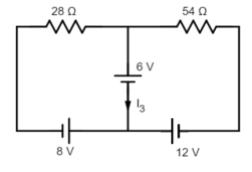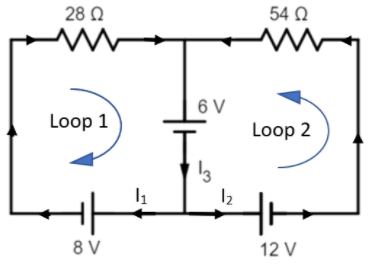
Consider the circuit shown in the figure. The current $I_3$ is equal to:

A). $5\;A$
B). $3\;A$
C). $-3\;A$
D). $-\dfrac{5}{6}\;A$

Answer
528.6k+ views
Hint: Use Kirchhoff’s Current Law to obtain an expression for $I_3$ in terms of the currents flowing across the $8\;V$ and $12\;V$ supply voltages. Then, divide the circuit into two independent loops and apply Kirchhoff’s Voltage Law to each to arrive at the magnitude of currents across the before mentioned supply voltages. Use Ohm’s Law to find the voltage drops across the resistance elements. Then plug the values of these currents into the Current law expression to arrive at an appropriate value for $I_3$.
Formula Used:
Kirchhoff’s Current Law (KCL): $I_{entering} + I_{exiting} = 0$
Kirchhoff’s Voltage Law (KVL): $\Sigma V =0$
Ohm’s law: $V=IR$
Complete step-by-step solution:
The only tools we need to solve this problem are Kirchhoff’s Current Law and Kirchhoff’s Voltage Law.
Kirchhoff’s Current Law (KCL) suggests that the algebraic sum of currents entering a node in a circuit will be equal to the sum of currents leaving the node.
Kirchhoff’s Voltage Law (KVL) suggests that the sum of all voltages around any closed loop in a circuit must be equal to zero.

From the above diagram, we see that we can apply KCL to the node in the lower part of the circuit that is in between the $8\;V$ and $12\;V$ batteries.
Applying KCL at this node, we get:
$I_3 = I_1 +I_2$
We thus need to find $I_1$ and $I_2$
Now, our circuit can be deconstructed into two loops as shown in the figure. Since our circuit consists of two independent closed loops, let us apply KVL to each and see how it goes from there.
In Loop 1, the $28\Omega$ resistor is powered by the current $I_1$ from the $8\;V$ supply.
Therefore, the voltage drop across this resistor will be $V = RI = 28I_1$
Now, applying KVL to Loop 1, we get:
$28I_1 + 6 +8 = 0 \Rightarrow 28I_1 = -6-8 = -14$
$\Rightarrow I_1 = \dfrac{-14}{28} = -\dfrac{1}{2}\;A$
Similarly, in Loop 2, the $54\Omega$ resistor is powered by the current $I_2$ from the $12\;V$ supply.
Therefore, the voltage drop across this resistor will be $V = RI = 54I_2$
Now, applying KVL to Loop 2, we get:
$54I_2 + 6 +12 = 0 \Rightarrow 54I_2 = -6-12 = -18$
$\Rightarrow I_2 = \dfrac{-18}{54} = -\dfrac{1}{3}\;A$
From the KCL equation, and the value of $I_1$ and $I_2$ that we found, we can now calculate $I_3$:
$I_3 = I_1 +I_2 = -\dfrac{1}{2} + \left(-\dfrac{1}{3}\right) = \dfrac{-3-2}{6} = -\dfrac{5}{6}\;A$. Therefore, the correct choice would be D. $-\dfrac{5}{6}\;A$
Note: Though we looked at KCL and KVL from a quantitative perspective, it is important to understand what they mean in a physical sense.
KCL signifies conservation of charge since the law basically suggests that the sum of currents entering a node must be equal to the sum of currents leaving the node, which means that electric charges are neither ambiguously lost nor mysteriously added but remains the same in an isolated system.
KVL signifies conservation of energy since the total energy in a system remains constant, though it may be transferred between components of the system in the form of electric potential and current.
Formula Used:
Kirchhoff’s Current Law (KCL): $I_{entering} + I_{exiting} = 0$
Kirchhoff’s Voltage Law (KVL): $\Sigma V =0$
Ohm’s law: $V=IR$
Complete step-by-step solution:
The only tools we need to solve this problem are Kirchhoff’s Current Law and Kirchhoff’s Voltage Law.
Kirchhoff’s Current Law (KCL) suggests that the algebraic sum of currents entering a node in a circuit will be equal to the sum of currents leaving the node.
Kirchhoff’s Voltage Law (KVL) suggests that the sum of all voltages around any closed loop in a circuit must be equal to zero.

From the above diagram, we see that we can apply KCL to the node in the lower part of the circuit that is in between the $8\;V$ and $12\;V$ batteries.
Applying KCL at this node, we get:
$I_3 = I_1 +I_2$
We thus need to find $I_1$ and $I_2$
Now, our circuit can be deconstructed into two loops as shown in the figure. Since our circuit consists of two independent closed loops, let us apply KVL to each and see how it goes from there.
In Loop 1, the $28\Omega$ resistor is powered by the current $I_1$ from the $8\;V$ supply.
Therefore, the voltage drop across this resistor will be $V = RI = 28I_1$
Now, applying KVL to Loop 1, we get:
$28I_1 + 6 +8 = 0 \Rightarrow 28I_1 = -6-8 = -14$
$\Rightarrow I_1 = \dfrac{-14}{28} = -\dfrac{1}{2}\;A$
Similarly, in Loop 2, the $54\Omega$ resistor is powered by the current $I_2$ from the $12\;V$ supply.
Therefore, the voltage drop across this resistor will be $V = RI = 54I_2$
Now, applying KVL to Loop 2, we get:
$54I_2 + 6 +12 = 0 \Rightarrow 54I_2 = -6-12 = -18$
$\Rightarrow I_2 = \dfrac{-18}{54} = -\dfrac{1}{3}\;A$
From the KCL equation, and the value of $I_1$ and $I_2$ that we found, we can now calculate $I_3$:
$I_3 = I_1 +I_2 = -\dfrac{1}{2} + \left(-\dfrac{1}{3}\right) = \dfrac{-3-2}{6} = -\dfrac{5}{6}\;A$. Therefore, the correct choice would be D. $-\dfrac{5}{6}\;A$
Note: Though we looked at KCL and KVL from a quantitative perspective, it is important to understand what they mean in a physical sense.
KCL signifies conservation of charge since the law basically suggests that the sum of currents entering a node must be equal to the sum of currents leaving the node, which means that electric charges are neither ambiguously lost nor mysteriously added but remains the same in an isolated system.
KVL signifies conservation of energy since the total energy in a system remains constant, though it may be transferred between components of the system in the form of electric potential and current.
Recently Updated Pages
Why are manures considered better than fertilizers class 11 biology CBSE

Find the coordinates of the midpoint of the line segment class 11 maths CBSE

Distinguish between static friction limiting friction class 11 physics CBSE

The Chairman of the constituent Assembly was A Jawaharlal class 11 social science CBSE

The first National Commission on Labour NCL submitted class 11 social science CBSE

Number of all subshell of n + l 7 is A 4 B 5 C 6 D class 11 chemistry CBSE

Trending doubts
What is meant by exothermic and endothermic reactions class 11 chemistry CBSE

10 examples of friction in our daily life

One Metric ton is equal to kg A 10000 B 1000 C 100 class 11 physics CBSE

1 Quintal is equal to a 110 kg b 10 kg c 100kg d 1000 class 11 physics CBSE

Difference Between Prokaryotic Cells and Eukaryotic Cells

What are Quantum numbers Explain the quantum number class 11 chemistry CBSE




